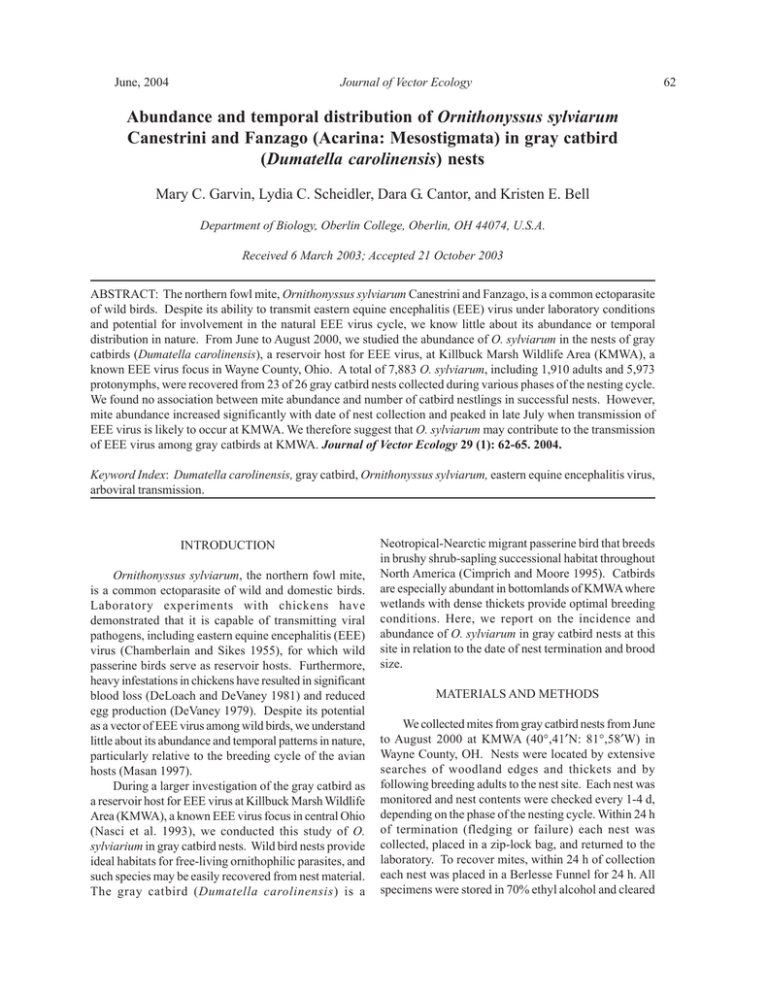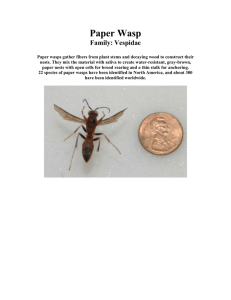Abundance and temporal distribution of Ornithonyssus sylviarum
advertisement

June, 2004 Journal of Vector Ecology Abundance and temporal distribution of Ornithonyssus sylviarum Canestrini and Fanzago (Acarina: Mesostigmata) in gray catbird (Dumatella carolinensis) nests Mary C. Garvin, Lydia C. Scheidler, Dara G. Cantor, and Kristen E. Bell Department of Biology, Oberlin College, Oberlin, OH 44074, U.S.A. Received 6 March 2003; Accepted 21 October 2003 ABSTRACT: The northern fowl mite, Ornithonyssus sylviarum Canestrini and Fanzago, is a common ectoparasite of wild birds. Despite its ability to transmit eastern equine encephalitis (EEE) virus under laboratory conditions and potential for involvement in the natural EEE virus cycle, we know little about its abundance or temporal distribution in nature. From June to August 2000, we studied the abundance of O. sylviarum in the nests of gray catbirds (Dumatella carolinensis), a reservoir host for EEE virus, at Killbuck Marsh Wildlife Area (KMWA), a known EEE virus focus in Wayne County, Ohio. A total of 7,883 O. sylviarum, including 1,910 adults and 5,973 protonymphs, were recovered from 23 of 26 gray catbird nests collected during various phases of the nesting cycle. We found no association between mite abundance and number of catbird nestlings in successful nests. However, mite abundance increased significantly with date of nest collection and peaked in late July when transmission of EEE virus is likely to occur at KMWA. We therefore suggest that O. sylviarum may contribute to the transmission of EEE virus among gray catbirds at KMWA. Journal of Vector Ecology 29 (1): 62-65. 2004. Keyword Index: Dumatella carolinensis, gray catbird, Ornithonyssus sylviarum, eastern equine encephalitis virus, arboviral transmission. INTRODUCTION Ornithonyssus sylviarum, the northern fowl mite, is a common ectoparasite of wild and domestic birds. Laboratory experiments with chickens have demonstrated that it is capable of transmitting viral pathogens, including eastern equine encephalitis (EEE) virus (Chamberlain and Sikes 1955), for which wild passerine birds serve as reservoir hosts. Furthermore, heavy infestations in chickens have resulted in significant blood loss (DeLoach and DeVaney 1981) and reduced egg production (DeVaney 1979). Despite its potential as a vector of EEE virus among wild birds, we understand little about its abundance and temporal patterns in nature, particularly relative to the breeding cycle of the avian hosts (Masan 1997). During a larger investigation of the gray catbird as a reservoir host for EEE virus at Killbuck Marsh Wildlife Area (KMWA), a known EEE virus focus in central Ohio (Nasci et al. 1993), we conducted this study of O. sylviarium in gray catbird nests. Wild bird nests provide ideal habitats for free-living ornithophilic parasites, and such species may be easily recovered from nest material. The gray catbird (Dumatella carolinensis) is a Neotropical-Nearctic migrant passerine bird that breeds in brushy shrub-sapling successional habitat throughout North America (Cimprich and Moore 1995). Catbirds are especially abundant in bottomlands of KMWA where wetlands with dense thickets provide optimal breeding conditions. Here, we report on the incidence and abundance of O. sylviarum in gray catbird nests at this site in relation to the date of nest termination and brood size. MATERIALS AND METHODS We collected mites from gray catbird nests from June to August 2000 at KMWA (40°,41′N: 81°,58′W) in Wayne County, OH. Nests were located by extensive searches of woodland edges and thickets and by following breeding adults to the nest site. Each nest was monitored and nest contents were checked every 1-4 d, depending on the phase of the nesting cycle. Within 24 h of termination (fledging or failure) each nest was collected, placed in a zip-lock bag, and returned to the laboratory. To recover mites, within 24 h of collection each nest was placed in a Berlesse Funnel for 24 h. All specimens were stored in 70% ethyl alcohol and cleared 62 June, 2004 Journal of Vector Ecology with either specimen clearing fluid (BioQuip., Gardena, CA) or 55% lactic acid. They were then mounted on microscope slides in euparal mounting medium (BioQuip Products, Inc.), and identified. Spearman’s rank correlation (SPSS, Inc, 2001) was used to test for an association between Julian date and number of mites per nest and between number of nestlings and abundance of mites. To control for the amount of time that the young had spent in the nest, for both analyses we used only those nests that successfully fledged young. 63 RESULTS A total of 7,883 O. sylviarum, including 1,910 adults and 5,973 protonymphs, was collected from 23 (88.5%) of the 26 gray catbirds nests examined (Table 1). Mite abundance per nest ranged from 0-3,401 and did not appear to be influenced by number of nestlings in successful nests (rs = 0.131, P = 0.642) which ranged from 1-4 (Table 1). Mite abundance increased significantly with Julian date in nests that fledged young (rs = 0.616, P = 0.014, Figure 1). The greatest infestations were detected in two nests that had recently fledged young during the last week of July. Table 1. Number of Ornithonyssus sylviarum in individual gray catbird nests relative to date of collection and status of nest. Date of collection 8 August 8 August 7 August 6 August 4 August 29 July 27 July 25 July 23 July 21 July 18 July 18 July 18 July 14 July 14 July 12 July 11 July 10 July 10 July 6 July 3 July 1 July 30 June 19 June 15 June 13 June TOTAL Stage of nest at collection (no. of nestlings) fledged (3) eggs fledged (1) fledged (3) eggs fledged (2) fledged (2) fledged (4) nestling (3) fledged (1) fledged (4) nestling (2) nestling (1) fledged (2) fledged (3) nestling (3) fledged (2) nestling (2) fledged (4) eggs fledged (3) fledged (4) nestling (3) nestling (3) fledged (3) nestling (1) No. of protonymphs 0 31 0 23 108 78 2,988 2,373 1 4 122 18 0 1 6 0 0 3 183 6 1 3 19 0 5 0 5,973 No. of adults 190 0 443 51 1 11 413 594 1 14 3 0 0 0 0 9 0 1 172 0 0 6 0 0 0 1 1,910 Total 190 31 443 74 109 89 3,401 2,967 2 18 125 18 0 1 6 9 0 4 355 6 1 9 19 0 5 1 7,883 64 Journal of Vector Ecology June, 2004 Number of mites per nest 4000 3000 2000 1000 0 -1000 160 170 180 190 200 210 220 230 Julian Date Figure 1. The association between Julian date and abundance of mites per successful gray catbird nest. Successful nests are those that fledged young. DISCUSSION The increase in mite abundance during the course of the breeding period is likely a result of the steady increase in the total number of mites in the catbird habitat (Masan 1997). Catbirds commonly make two nesting attempts per breeding season, constructing a new nest for each attempt (Cimprich and Moore 1995). Therefore, nesting material from old nests is not reused and mites from abandoned nests migrate to active nests in search of new hosts (Sikes and Chamberlain 1954). Ambient conditions and resulting nest microclimate were not measured in this study and may also have contributed to the observed temporal pattern of abundance. The number of nestlings occupying the nest did not appear to influence mite abundance. This result is consistent with the work of Darolova et al. (1997) who also found no relationship between abundance of O. sylviarum and number of penduline tit (Remiz pendulinus) nestlings. However, this is in contrast with studies by Masan (1997) who found a positive correlation between penduline tit clutch size and number of mites per nest. Because the results of the current study could be an artifact of sample size, a more extensive study of gray catbirds could reveal a positive correlation as well. The greatest abundance of mites per nest observed later in the summer coincides with seasonal EEE activity detected in gray catbirds at KMWA (Garvin et al. 2003). Although Culiseta melanura Coquillett (Diptera: Culicidae) is considered the primary enzootic vector of EEE virus at inland EEE foci (Chamberlain et al. 1958), Crans et al. (1994) suggested that ornithophilic mites may also contribute to the natural transmission cycle. Given that O. sylviarum feeds at least once every 24 h (DeLoach and DeVaney 1981) and protonymphs require at least two feedings at 1-2 d intervals (Sikes and Chamberlain 1954), mites could acquire infection by feeding on an infected brooding female and transmit the infection to a nestling through a subsequent blood meal. Thus, O. sylviarum could contribute to maintenance of the virus in the avian reservoir host population, especially during interepizootic years when epizootic mosquito vectors are less abundant. Moreover, O. sylviarum could also play a role in transmission of EEE and other arboviruses to humans in light of its tendency to bite mammals when present in large numbers and in the absence of a suitable avian host (Cameron 1938, Schmidt and Roberts 1989). Clearly, the positive correlation reported here between number of mites per nest and Julian date is due to the large number of mites in nests collected in late July. Nonetheless, great variance and large numbers of mites in late season broods have been reported for the house sparrow, Passer domesticus (Phillis 1972), and therefore may be an accurate reflection of seasonal mite abundance in gray catbirds as well. June, 2004 Journal of Vector Ecology Acknowledgments This study was generously funded by Oberlin College and a grant from the Howard Hughes Medical Institute to Oberlin College. We thank Laura Vineyard for assistance with lab work, Keith Tarvin for review of this manuscript, and Hans Klompen, Acarology Laboratory, Museum of Biological Diversity, Ohio State University for guidance in mite identification. We also thank the staff of KMWA, Ohio Department of Natural Resources, especially Kevin Higgins, for assistance and logistical support. REFERENCES CITED Cameron, D. 1938. The northern fowl mite (Liponyssus sylviarum C. & F., 1877). Investigations at MacDonald College, Que., with a summary of previous work. Canad. J. Research 16 Sect. D: 230254. Chamberlain, R.W. and R.K. Sikes. 1955. Laboratory investigations of the role of bird mites in the transmission of eastern and western encephalitis. Am. J. Trop. Med. Hyg. 4: 106-118. Chamberlain, R.W., W.D. Sudia, P.P. Burbutis, and M.D. Bogue. 1958. Recent isolations of arthropod borne viruses from mosquitoes in the eastern United States. Mosq. News 18: 305-308. Cimprich, D.A. and F.R. Moore. 1995. Gray Catbird (Dumetella carolinensis). In: A. Poole and F. Gill (eds.). Birds of North America, No. 167. The Birds of North America, Inc., Philadelphia, PA. Crans, W.J., D.F. Caccamise, and J.R. McNelly. 1994. Eastern equine encephalitis virus in relation to the avian community of coastal cedar swamp. J. Med. Entomol. 31: 711-728. Darolova, A., H. Hoi, and B. Schleicher. 1997. The effect 65 of ectoparasite nest load on the breeding biology of the penduline tit Remiz pendulinis. Ibis 139: 115120. DeLoach, J.R. and J.A. DeVaney. 1981. Northern fowl mite, Ornithonyssus sylviarum (Acari: Macronyssidae), ingests large quantities of blood from white leghorn hens. J. Med. Entomol. 18: 374377. DeVaney, J.A. 1979. The effects of the northern fowl mite, Ornithonyssus sylviarum, on egg production and body weight of caged White Leghorn hens. Poultry Sci. 58: 191-194. Garvin, M.C., O.A. Ohajuruka, K.E. Bell, and S.L. Ives. 2003. Seroprevalence of eastern equine encephalitis virus in birds and larval survey of Culiseta melanura (Coquillett) during an interepizootic period in central Ohio. J. Wildl. Dis. 39: 582-587. Masan, P. 1997. Changes in infestation rate and age structure of Dermanyssus hirundinis and Ornithonyssus sylviarum (Acarina) during nidification and breeding period of penduine tit. J. Med. Entomol. 34: 609-614. Nasci, R.S., R.L. Berry, R.A. Restifo, M.A. Parsons, G.C. Smith, and D.A. Martin. 1993. Eastern equine encephalitis virus in Ohio during 1991. J. Med. Entomol. 30: 217-222. Phillis, W. 1972. Seasonal abundance of Dermanyssus hirundinis and D. americanus (Mesostigmata: Dermanyssidae) in nests of the house sparrow. J. Med. Entomol. 9: 111-112. Schmidt, G.D. and L.S. Roberts. 1989. Foundations of Parasitology. Times Mirror-Mosby. St. Louis, MO. Sikes, R.K. and R.W. Chamberlain. 1954. Laboratory observation of three species of bird mites. J. Parasitol. 40: 691-697. SPSS, Inc. 2001. SPSS for Windows. Ver 11.0 Chicago, IL.




